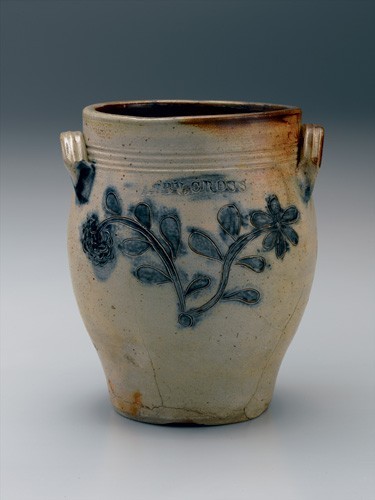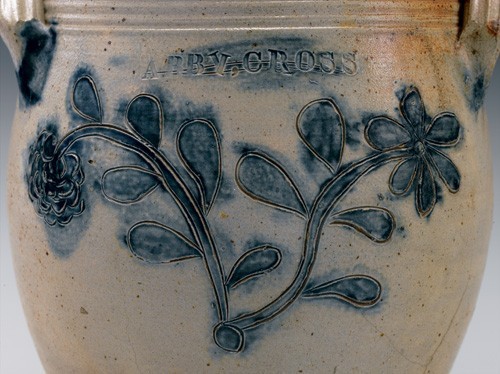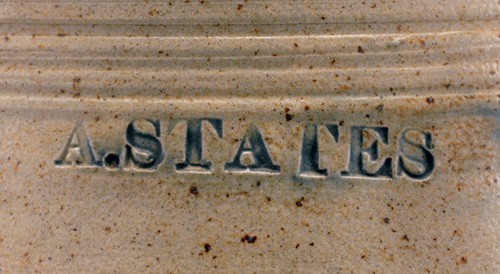
Storage jar, Adam States II, Stonington, Connecticut, 1820–1826. Salt-glazed stoneware. H. 9". This ovoid jar has applied, flattened, and ribbed handles, incised lines approximately one inch below the rim, and an early footed base. The interior has a dark Albany slip glaze. Small clay imperfections can be seen on the surface of the pot.

Detail of the stamp on the pot illustrated in fig. 1.

Detail of the stamp on the back of the pot illustrated in fig. 1.
Salt-glazed stoneware was made in America beginning in the early years of the eighteenth century and reached its peak of development in the first quarter of the nineteenth century. By the early years of the twentieth century its importance as useful utilitarian ware, folk art form and decoration, and production had declined to near extinction.
The vast majority of American stoneware made during this two-hundred-year period was produced in quantity and for utilitarian purposes. Periodically, however, potters would create a single piece in honor of a specific individual. The name of the individual was inscribed on the piece in some manner and, presumably, given to him or her as a gift. These special objects, termed “presentation” pieces, number among the most beautifully decorated and historically intriguing stoneware items ever produced.
One such presentation piece, made for Abby Hinckley Cross by the Adam States II pottery in Stonington, Connecticut, is believed to date from between 1820, the approximate year of Abby’s marriage, and 1826, the year of Adam’s death. Impressed on the front is “ABBY, CROSS,” beneath which are two deeply incised flowers (fig. 1). One flower is daisylike in appearance, having six petals and an impressed circle in the center. The other is more like a carnation, with many deeply incised petals. The stems have large incised leaves and are joined at their bases. On the reverse is impressed “A.STATES” (figs. 2, 3). Cobalt decoration was applied at the base of the handles, over Abby Cross’s name, within the floral decoration, and inside the potter’s stamp.
Abby Cross
Abby Cross’s family tree includes members of families that were direct descendants of James Babcock, Allen Breed, George Lawton, Thomas Hazard, and Reverend John Lothrup, some of the earliest settlers and founders of some of the most prominent seventeenth- and eighteenth-century families of New England.
Abby was born in Stonington, Connecticut, in 1802, the second child of Samuel Hobart Hinckley (b. 1772), a farmer, and Abigail Helme (b. 1772), both of whom were also born in Stonington.[1] Abby married George Dilwyn Cross (b. 1799) in Westerly, Rhode Island, and gave birth to seven sons and four daughters between 1821 and 1843.
George Cross (1799–1872) was a lawyer and entrepreneur. He served six terms in the state’s general assembly, served as a state senator, chief justice of the Court of Common Pleas for Washington County, and, in 1840, was appointed by the State of Rhode Island to be one of the commissioners to survey and adjust the long-disputed boundary line between Connecticut and Rhode Island.[2]
Samuel Hinckley Sr. (1589–1662), the progenitor of the Hinckley family, came to America from Trenterden, County Kent, England, arriving at Boston in 1634. In 1635 he moved to Scituate, Massachusetts, where in 1637 he was made a freeman.[3] In 1640 he moved to Barnstable, Massachusetts, where he remained until his death. His eldest son, Thomas, became the governor of Plymouth Colony; his youngest son, John (b. 1644), was the second progenitor of the branch of the family to which Abby belongs.
John’s second child, Samuel Hinckley (b. 1670), was the first of the Hinckley family to settle in Stonington. His son Samuel Jr. (b. 1705/6) had a son, Abel. Abel’s second son and sixth child was Samuel Hobart Hinckley, Abby’s father.[4]
Abby’s maternal grandfather, Oliver Helme, was a descendant of Christopher Helme (b. ca. 1615) of Long Sutton, Lincolnshire, England. Christopher immigrated to Boston, where it is believed he arrived in July 1637 as a member of a party led by Reverend John Wheelwright, a clergyman from Lincolnshire. Wheelwright, banished from Massachusetts for his religious beliefs, established himself and his followers on land near the Piscatoquake River now known as Exeter.
Christopher Helme was one of the thirty-four signers of the Exeter combination on May, 4, 1639. By 1644 he had settled in Warwick, Rhode Island, where he was received as a free inhabitant.[5]
Christopher’s second son, Rouse Helm (b. 1641/44), was one of the early settlers of Kingstown, Rhode Island. Rouse’s son Rouse II (b. 1683), Oliver’s father, was clerk of the state assembly in 1720, an assistant justice of the peace, and a superior court judge. Oliver was born in South Kingston where, in 1753, he was made a freeman. He moved to Connecticut in 1760.
Abby’s grandmother Katharine’s great-great-great-grandfather John Greenman (b. 1602, Somersetshire, England) immigrated to America and was admitted as a freeman in Dorchester (now Boston) in 1631. In November 1636 he was one of the forty-six original purchasers of land from the Indians in Taunton, Massachusetts. On May, 20, 1638, he was admitted as a freeman in Newport, Rhode Island.
John’s son Edward (b. ca. 1630), who was born either in England or in Dorchester, Massachusetts, was admitted as a freeman in Newport in 1655 and in Westerly in 1661. In 1661 a tract of land called Misquamicut (now Westerly) was purchased from Sosooa, a Native American. Edward purchased a quarter of a share of this tract. Edward served as a commissioner and deputy to the General Assembly. Edward’s son Edward Jr. (b. 1663) was admitted as a freeman in Kingstown, Rhode Island, in 1696. He served as a deputy to the General Assembly for Kingston and speaker of the House of Deputies. Edward Jr.’s son, Silas (b. ca. 1690), Katharine’s father, was a merchant and a judge. He also served as the town clerk of Westerly and as deputy to the General Assembly.[6]
Adam States II
Adam States II was the second of three Adam States who produced stoneware in Connecticut in the eighteenth and early nineteenth centuries.
Adam States I emigrated from Holland and initially settled in South Amboy, New Jersey. By 1743 he was in New York, in 1746 he was in Pennsylvania, then he moved to Rye, New York, and by 1750 was in Greenwich, Connecticut, where he established a pottery and remained until his death, in 1769.
Adam II, born June 8, 1756, in Greenwich, was the sixth child of Adam States I. He was indentured to and learned the pottery trade from his uncle Peter. Soon after his marriage in 1778 to Esther Noyes of Stonington, Adam developed a pottery business in Stonington, living and working there until his death in 1826. He was married three times and fathered fifteen children.
Adam States III, the first child of Adam II, was born in Stonington in 1781. He owned one-half interest in a pottery at Stonington Borough/Long Point, which he operated during the years of 1812–1816 and 1819–1821 with his cousin William (son of Peter, to whom his father had been indentured).[7]
Connecting the States and the Hinckley Families
Westerly, Rhode Island, and Stonington, Connecticut, were closely knit neighboring communities. Although information has not been found linking the States family of Westerly and Stonington and the Samuel Hinckley families through marriage, it can be shown that they were certain to have known each other as neighbors and fellow church members.
Adam States II, Nathan and Elijah Hinckley (brothers of Abby’s grandfather Abel), and Oliver Helme were members of Westerly’s Hill Church, for which Helme served as clerk beginning in June 1784. During this time, in order to avoid state taxes, residents of Connecticut were issued certificates verifying their membership in the church.[8]
Peter States (also known as Staats) (b. ca. 1720), Adam II’s uncle, owned land in Stonington that bordered property owned by Oliver Helme and John and Thomas Hinckley.[9]
Benjamin States
Another pot exists (not pictured here) that was made by the same hand and during the same time period as Abby’s jar. This second piece is a two-gallon, straight-sided pot, decorated on one side with deeply incised flowers with long stems that meet and are joined at their bases with several small leaves. There are a number of incised lines approximately one inch below the rim. The handles are flattened and ribbed. The inside has an Albany slip glaze, and clay imperfections can be seen on the vessel’s surface. The flowers, stems, and leaves are filled with cobalt, and cobalt brushstrokes appear at the ends of the handles. The front of the pot is marked “B STATES”—upside down—in two places, one below the incised lines near the rim, the other above the incised lines. Both marks are brushed with cobalt.
It is reasonable to believe that this piece was made either for or with the help of Benjamin States (b. 1809), Adam State II’s fifteenth child and youngest son. If he had trained as a potter in his younger years, Benjamin ultimately chose to become a merchant and civic leader. He held many public positions, including deputy sheriff, constable, tax collector, captain of the local Light Artillery, notary public, commissioner of the New York and Stonington Railroad, and collector of customs.[10]
Two stoneware vessels made by members of the States family’s long line of potters come to life as information about those who made them and those who received them becomes known. These two pieces, both made in Stonington, each tell a different story, separate yet intertwined.
Adam and Benjamin’s story is of three generations of potters who produced beautiful objects under relatively primitive conditions. Their pots serve as a fine reminder of these talented men. Abby’s story is of a woman, wife, and mother. We see her jar and think of her, her family, the immigrants she descended from, and how important they were to the founding and development of America. Two pieces of stoneware, each a product and symbol of the rich American heritage that is ours.
Kathryn Boxhorn; jfentonboston@aol.com
Her grandparents on her mother’s side were Oliver Helme (b. June 17, 1731) and Katharine Greenman (b. April 22, 1738), of the well-known shipbuilding family of Westerly and Mystic. On her father’s side her grandparents were Abel Hinckley Sr. (b. April 10, 1743) and Sarah Hubbard (Hobart) (b. ca. 1745).
Thomas William Herringshaw, Herringshaw’s Encyclopedia of American Biography of the Nineteenth Century (Chicago: American Publisher’s Association, 1902), p. 206.
“One enjoying civil or political liberty; one having the full rights of a citizen.” Merriam-Webster’s Collegiate Dictionary, 10th ed., s.v. “freeman.”
Biographical Review Containing Life Sketches of Leading Citizens of New London County, Connecticut (Boston: Biographical Review Publishing Company, 1898), vol. 26, p. 115.
Howard M. Chapin, The Early Records of the Town of Warwick (Providence, R.I.: E. A. Johnson Company, 1926), p. 217.
Elisha R. Potter Jr., The Early History of Narragansett (Providence, R.I.: Marshall, Brown and Company, 1835), pp. 250, 255.
Lura Woodside Watkins, Early New England Potters and Their Wares (Hamden, Conn.: Archon Books, 1968), pp. 178–82.
In his book Genealogy of the States Family (New Haven, Conn., 1913), James Noyes States includes the following information:
Adam, the sixth child, was born at Greenwich, Conn. in 1756, and died at Stonington, Conn., near Westerly, R.I. in 1826, aged 70 years. His grave is in a family burial place not far from Westerly on the west side of the Pawcatuch River, on the west side of the road going north towards North Stonington. In 1909, the place was owned by a man by the name of Hall, whose grandmother, Phoebe C. (States) Bliven, was the daughter of Adam States (3rd) of this paper, and Fanny (Chesebrough) States, his wife. The house was struck by lightning and burned down. It was on the west side of the road about opposite the house of Thomas Hinckley.
Harold Staats, Genealogy of the Staats Family (Ripley, W.Va.: National Staats Reunion Association, 1921), p. 204.
Ibid., pp. 182, 183.
